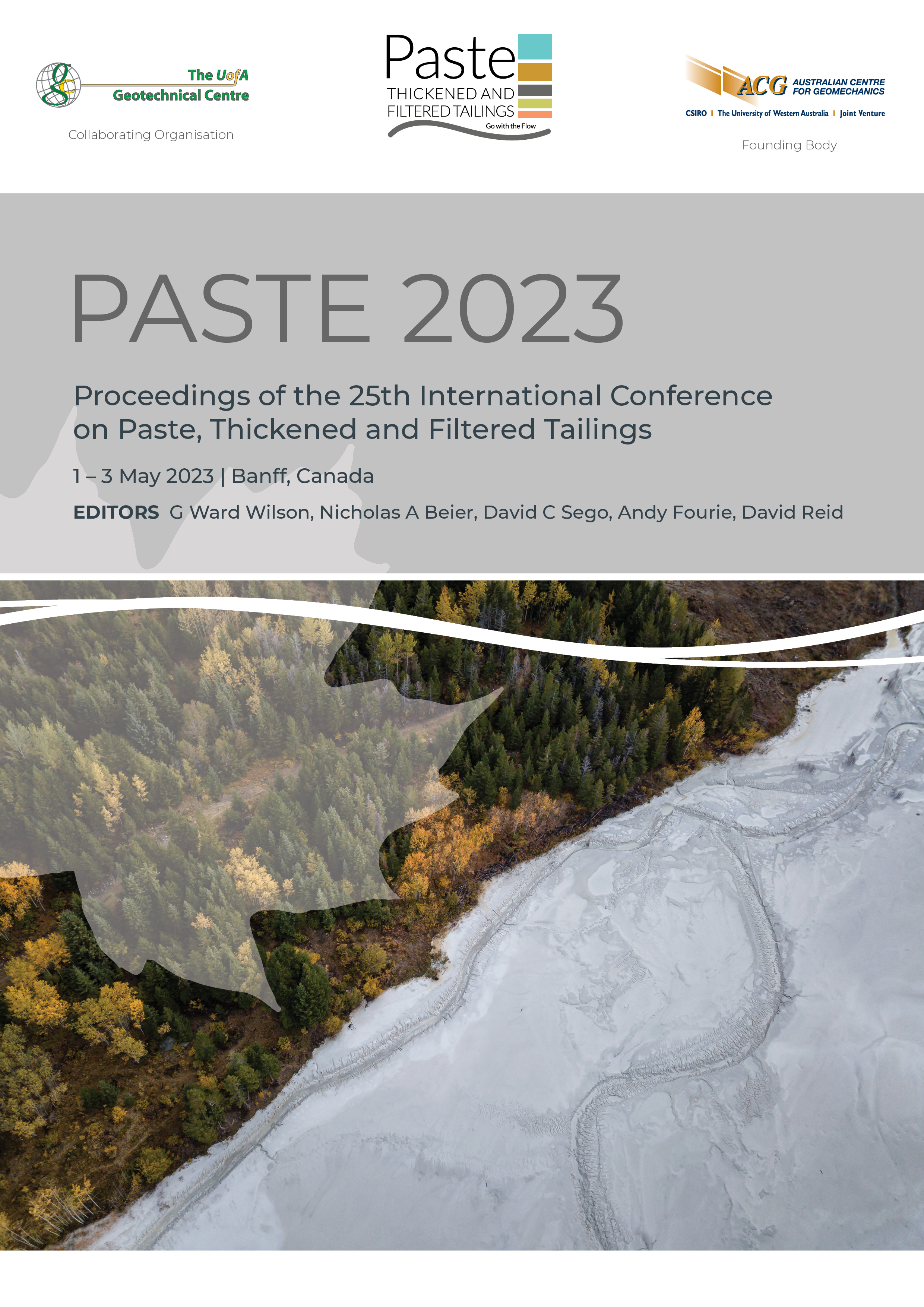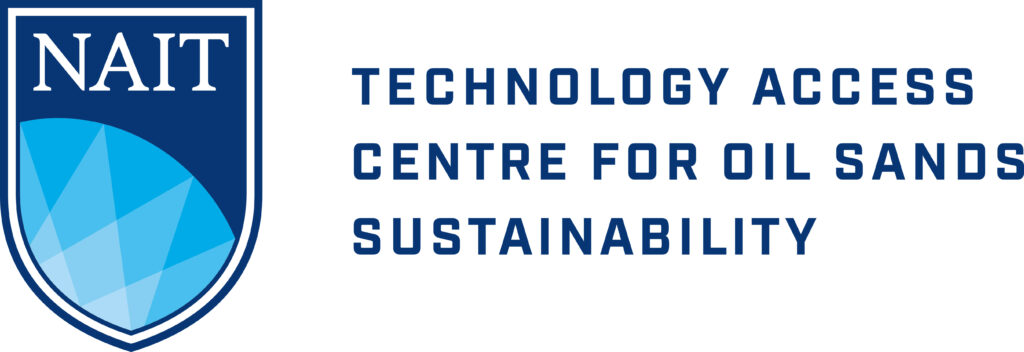Tailings dewatering with the EKS-DT process

|
Authors: Vandersleen, JK; Hanna, JE |
DOI https://doi.org/10.36487/ACG_repo/2355_31
Cite As:
Vandersleen, JK & Hanna, JE 2023, 'Tailings dewatering with the EKS-DT process', in GW Wilson, NA Beier, DC Sego, AB Fourie & D Reid (eds), Paste 2023: Proceedings of the 25th International Conference on Paste, Thickened and Filtered Tailings, Australian Centre for Geomechanics, Perth, pp. 414-428, https://doi.org/10.36487/ACG_repo/2355_31
Abstract:
The global inventory of tailings is currently >55 billion m3 and is forecast to increase to almost 70 billion m3 by 2025. The cost of these tailings includes the construction and maintenance of tailings storage facilities (TSFs), the liability of catastrophic releases, environmental damages, and erosion of social licence to continue mining. Billions of dollars and decades of research have been spent searching for improved technologies to better dewater tailings and reclaim TSFs. The ElectroKinetic Solutions Inc. (EKS) tailings dewatering technology (EKS-DT) process has been developed to dewater legacy and fresh tailings in situ, using electrokinetics. Over more than a decade of lab and field-scale testing has significantly improved the technology’s dewatering effectiveness and reliability and confirmed its commercial viability. The process is less costly compared to current tailings management technologies and excels in its ESG performance. EKS has shown through a field demonstration that very fine-grained tailings (i.e. average particle size <6 microns) with an initial solids content of 20% (kg/kg) can be dewatered to >60%. EKS has also produced a forecasting model. The model accurately forecasts dewatering time and energy consumption for different designs and operating schedules, critical information for designing commercial installations. A 1,700 m3 field demonstration from 2019 to 2021 proved that the technology is commercially viable. During this time, over 1,100 m3 of water was removed from the tailings and the energy consumption was <15 kWh per m3 of water released. The process was operated year-round through two harsh winters. The process operated as well during the ice-covered period as during warmer months. The installation was operated continuously by the automated control system without an onsite operator. The design of the first commercial installations of the technology is now underway. The engineering design process for the field demonstration and for commercial systems will be discussed, including the role of the EKS model.
Keywords: electrokinetics, tailings, dewatering, water recovery, increased capacity
References:
Abraham, T, Lam, N, Xu, J, Zhang, D, Wadhawan, H, Kim, HJ, … & Thundat, T 2018, ‘Collapse of house-of-cards clay structures and corresponding tailings dewatering induced by alternating electric fields’, Drying Technology, vol. 37, no. 9, pp. 1053–1067.
Baker, E, Davies, M, Fourie, A, Mudd, G, & Thygesen, K 2020,‘Mine tailings facilities: overview and industry trends’, in B Oberle, D Brereton, & A Mihaylova (eds), Towards Zero Harm – A Compendium of Papers Prepared for the Global Tailings Review, St Gallen, pp.14–24.
Casagrande, L 1949, ‘Electro-osmosis in soils’, Geotechnique, vol. 1, no. 3, pp. 159–177.
Dixit, SP, Gombeer, R, & D’hoore, J 1975, ‘The electrophoretic mobility of natural clays and their potential mobility within the pedon’, Geoderma, vol. 13, issue 4, pp. 325–330.
Franks, DM, Boger, DV, Côte, CM & Mulligan, DR 2011, ‘Sustainable development principles for the disposal of mining and mineral processing wastes’, Resources Policy, vol. 36, no. 2, pp. 114–122.
Ghorbani, Y & Kuan, SH 2017, ‘A review of sustainable development in the Chilean mining sector: past, present and future’, International Journal of Mining, Reclamation and Environment, vol. 31, no. 2, pp. 137–165.
Islam, S 2014, Thickening of Mature Fine Oil Sands Tailings, PhD thesis, University of Western Ontario, London.
Jeeravipoolvarn, S, Scott, JD & Chalaturnyk, RJ 2009, ‘10 m standpipe tests on oil sands tailings: Longterm experimental results and prediction’, Canadian Geotechnical Journal, vol. 46, no. 8, pp. 875–888.
Lo, KY, Inculet, II & Ho, KS 1990, ‘Electroosmotic strengthening of soft sensitive clays’, Canadian Geotechnical Journal, vol. 28,
pp. 62–73.
Lockhart, NC 1983, ‘Electroosmotic dewatering of clays. 1. influence of voltage’, Cotloids and Surfaces, vol. 6, pp. 229–238.
Long, J, Li, H, Xu, Z & Masliyah, JH 2006, ‘Role of colloidal interactions in oil sand tailings treatment’, AIChE Journal, vol. 52, no. 1, pp. 371–383.
McKenna, G & VanZyl, D 2020,‘Closure and reclamation’, in B Oberle, D Brereton, & A Mihaylova (eds), Towards Zero Harm – A Compendium of Papers Prepared for the Global Tailings Review, St Gallen, pp.109–127.
Nasirov, S & Agostini, CA 2018, ‘Mining experts’ perspectives on the determinants of solar technologies adoption in the Chilean mining industry’, Renewable and Sustainable Energy Reviews, vol. 95, no. July, pp. 194–202,
10.1016/j.rser.2018.07.038.
Owen, JR, Kemp, D, Lèbre, Svobodova, K & Pérez Murillo, G 2020, ‘Catastrophic tailings dam failures and disaster risk disclosure’, International Journal of Disaster Risk Reduction, vol. 42.
publications/383
Shang, J & Dunlap, W 1996, ‘Improvement of soft clay by high voltage electronics’, Journal of Geotechnical and Geoenvironmental Engineering, vol. 122, no. 4, pp. 274–280.
Shang, JQ & Xu, Y 2019, ‘Electrokinetic dewatering of mine tailings from hydrometallurgical processes’, in AJC Paterson, AB Fourie & D Reid (eds), Paste 2019: Proceedings of the 22nd International Conference on Paste, Thickened and Filtered Tailings, Australian Centre for Geomechanics, Perth, pp. 275–283,
Shang, JQ 1997, ‘Electrokinetic sedimentation: a theoretical and experimental study’, Canadian Geotechnical Journal, vol. 34, pp. 305–314.
Sutherland, BR, Barrett, KJ, Gingras, MK, Sutherland, BR, Barrett, KJ & Gingras, MK 2015, ‘Clay Settling in Fresh and Salt Water’, Environmental Fluid Mechanics, vol. 15, pp. 147–160.
© Copyright 2025, Australian Centre for Geomechanics (ACG), The University of Western Australia. All rights reserved.
View copyright/legal information
Please direct any queries or error reports to repository-acg@uwa.edu.au
View copyright/legal information
Please direct any queries or error reports to repository-acg@uwa.edu.au



